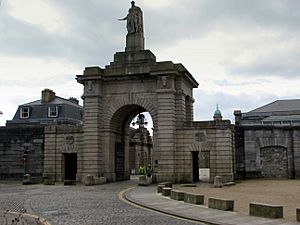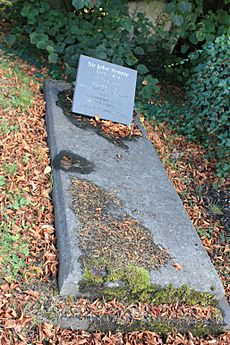John Rennie the Younger facts for kids
Quick facts for kids
John Rennie
|
|
|---|---|

John Rennie the Younger
|
|
| Born | 30 August 1794 |
| Died | 3 September 1874 (aged 80) Bengeo, Hertfordshire, England, United Kingdom
|
| Nationality | British |
| Occupation | Engineer |
| Engineering career | |
| Discipline | Civil engineer |
| Institutions | Institution of Civil Engineers (president) |
| Projects | Waterloo Bridge Southwark Bridge London Bridge |
Sir John Rennie (born August 30, 1794 – died September 3, 1874) was a famous British engineer. He was the second son of another well-known engineer, John Rennie the Elder. His brother, George Rennie, was also an engineer. John Rennie followed in his father's footsteps, designing many important bridges, docks, and other structures.
Contents
Early Life and Training
John Rennie was born in London in 1794. He went to school in Isleworth and Greenwich. After finishing school, he joined his father's workshop. This is where he learned practical engineering skills.
In 1813, he helped supervise the building of Waterloo Bridge. He worked on its foundations. In 1815, he also helped his father with Southwark Bridge. In 1819, he traveled to Europe to study big engineering projects there.
Working with His Brother
When his father passed away in 1821, John and his brother George continued the family business. Their company was called J. & G. Rennie. John focused on civil engineering, which involves building things like bridges and canals. George handled mechanical engineering, which is about machines.
Important Building Projects
John Rennie designed many large and important structures.
Royal William Victualling Yard

From 1823 to 1833, Rennie helped design the Royal William Victualling Yard in Plymouth. A "victualling yard" was a place where supplies like food and drink were stored for the Royal Navy.
This huge complex covered about 14 acres (5.7 hectares). It was built using Plymouth limestone and Dartmoor granite. The main entrance has a grand gateway with a statue of King William IV. Inside, there were buildings like a slaughterhouse, a bakery, and a brewery. There was also a large warehouse with a clock tower.
Cannon Workshops
Rennie also designed the Cannon Workshops. These buildings were created after workers at the West India Dock Company went on strike. The company needed to reorganize its barrel-making department. Rennie drew up the plans in 1824, and the buildings were finished in 1825.
Bridges and Water Projects
One of John Rennie's most famous projects was building London Bridge. His father had designed it, and John took over the construction starting in 1824. The bridge opened in 1831. John Rennie was knighted for this achievement. He was one of the first engineers to receive this honor.
As an engineer for the Admiralty (the British Navy's department), he completed many projects. These included works at Sheerness, Woolwich, Plymouth, and Ramsgate. He also finished the huge breakwater at Plymouth. A breakwater is a barrier built in the sea to protect a harbor from waves. He wrote a book about it in 1848.
Rennie spent many years improving harbors and waterways in England and Ireland. For example, he designed a drydock for a shipbuilder in Cork, Ireland, in the 1850s. A drydock is a special dock that can be drained of water, allowing ships to be built or repaired on dry land.
He also completed drainage projects in the Lincolnshire fens, which his father had started. He worked with Thomas Telford to build the Nene outfall near Wisbech (1826–1831). He also improved the harbor of Boston and the River Welland. In 1862, he modernized the Chatham Dockyards, creating three large basins and passageways.
Railway Engineering
John Rennie and his brother were involved in early railway projects. They worked with George Stephenson on the design of the Liverpool and Manchester Railway. Their company also supplied locomotives for the London and Croydon Railway in 1838 and 1839.
In 1852, John Rennie planned a railway system for Sweden. For this, he received an award called the Order of Gustavus Vasa. In 1855, he designed railways and harbors for Portugal. However, these plans were not built.
Leading the Institution of Civil Engineers
Rennie became a member of the Institution of Civil Engineers in 1844. He was then elected president in 1845 and held the position for three years. In his 1846 speech, he gave a complete history of civil engineering. He also wrote papers about drainage and improving river navigation.
Besides his book on the Plymouth Breakwater, he also published The Theory, Formation, and Construction of British and Foreign Harbours (1851–54). He was also chosen as a foreign member of the Royal Swedish Academy of Sciences.
Later Life and Passing
John Rennie retired from his engineering work around 1862. He passed away on September 3, 1874, near Hertford, shortly after his 80th birthday.
He is buried in Kensal Green Cemetery in London. His grave has a new plaque because the original one had worn away.


